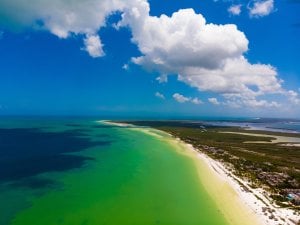The most recent report from Mexico’s Navy Department, dated March 18, 2023, states that up to one meter of sargassum could accumulate on the coast of the state of Quintana Roo, called the “Riviera Maya,” in the coming week alone.
An estimated 200 tons of brown algae (sargassum) will wash up on the beaches of the Riviera Maya during this period. While this sounds like a lot, it is only a fraction of the estimated 26,000 tons believed to exist in the Caribbean.
For all the sea & sand seakers drawn to CaribThe most recent report from Mexico’s Navy Department, dated March 18, 2023, states that up to one meter of sargassum could accumulate on the coastbean beaches, this is more bad news, especially since there are no signs that the situation will ease in the near future.
Authorities have placed this forecast in Category 7, meaning that the affected beaches will not be usable again until the cleanup is complete.
Currently free of Sargassum (March 20) are only the beaches of Isla Mujeres and Isla Holbox.
Why has there been so much sargassum for several years?
In short, there is no consensus on what exactly is causing the huge increase in sargassum in the Caribbean since the first reports in 2011. The two most commonly cited theories, though sometimes controversial, are as follows:
In most cases, climate change is seen as an amplifying factor, but not a contributing causal factor. The decreasing number of seasonal hurricanes means that the giant Sargassum rafts out in the Atlantic are no longer regularly chewed up and dispersed. In addition, rising ocean temperatures are accelerating the growth of brown algae.
The fact that agricultural runoff from Brazil, which enters the Atlantic via the Amazon, is the main cause of the explosive growth of Sargassum in the Caribbean is a subject of controversy, but considered by many scientific experts to be the most plausible theory. According to this theory, fertilizers and sewage from the Amazon continue to act as a fertilizer, but not for the fields in Brazil, but for the Sargassum in the Caribbean and the Atlantic.
To all interested parties and vacation planners, we further recommend the following links to follow the situation on a daily basis: https://www.facebook.com/RedSargazo is the most up-to-date source on the situation in the Mexican Riviera Maya, while the platform https://sargassummonitoring.com/ follows the situation in the entire Caribbean region.

